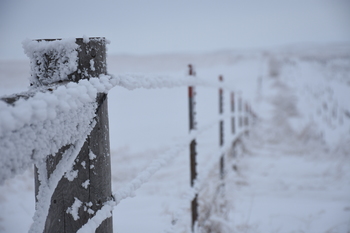Don't Let Hypothermia Sneak Up This Winter
by Christina Krieger
December 2020
It is no secret that when it comes to weather, from the hot and humid summers to the cold and windy winters, North Dakota experiences the extremes. Not only do North Dakotans tolerate these temperatures, they even venture outside during them – especially in this area, where Theodore Roosevelt National Park and other beautiful sights are so near.
Even with the constant changes in outdoor temperatures, the human body has an incredible ability to maintain a core temperature of about 98.6 degrees Fahrenheit. When this balance is disrupted, problems start. With winter being a significant portion of the year in North Dakota, it is crucial to understand hypothermia.
Hypothermia occurs when the body loses more heat than it can produce. Hypothermia's three early signs are uncontrolled shivering, skin changes, and frequent urination. Uncontrolled shivering comes from many small muscle movements, which generate extra heat for the body. The skin becomes pale and cold when the surface blood vessels constrict, shunting blood to deeper, more vital organs. As this shunted blood is being filtered by the kidneys faster, more frequent urination occurs.
Next come the brain symptoms: confusion, unsteadiness, disorientation, and drowsiness. These symptoms mean the individual experiencing hypothermia may not even realize what is happening. Other signs include increased pulse and faster breathing. As hypothermia gets more severe, pulse and breathing begin to slow while confusion and exhaustion intensify.
 Several things can make an important
difference in the prevention of hypothermia. First,
day-to-day, be aware of the weather, wear plenty of
layers of clothing, and keep some sort of winter survival
kit in vehicles. Second, when going on an outdoor
adventure like hiking or hunting, be sure to have the
proper gear, stay hydrated, cover all parts of the body,
and wear several layers of loose clothing.
Several things can make an important
difference in the prevention of hypothermia. First,
day-to-day, be aware of the weather, wear plenty of
layers of clothing, and keep some sort of winter survival
kit in vehicles. Second, when going on an outdoor
adventure like hiking or hunting, be sure to have the
proper gear, stay hydrated, cover all parts of the body,
and wear several layers of loose clothing.
Hypothermia is a medical emergency. In rural areas of North Dakota, medical help may be delayed and it’s important to be familiar with some life-saving measures while waiting for medical help to arrive. Remove the person from the cold, wet, or windy weather if possible. Next, remove wet clothes wrap the individual in warm, dry clothing or blankets. Make sure to cover their head and neck to avoid heat loss from those areas. Providing a warm drink can also help, but avoid alcoholic drinks.
In cases of severe hypothermia, the individual might seem to not be breathing or have a pulse. Call 911 and perform CPR, even if they appear to be dead. There have been several cases where individuals were so profoundly hypothermic, that they appeared dead. After warming and medical intervention, however, they made a full recovery. This is why there is a saying, “nobody is dead until they are warm and dead.”
Although not common, deaths from hypothermia do happen in North Dakota. One study found that of all cold-related deaths, many more occur on the “moderately cold” days rather than the “extremely cold” ones. Death rates from hypothermia also increase steadily with age, with the highest rates being in those aged 85 and older. When comparing urban to rural areas, the death rates in rural areas were higher – almost double – in every age group. This is significant, considering that the vast majority of North Dakota is rural.
In a place like North Dakota, where the seasons are always changing and the people are adventurous, it is essential to realize the importance of being prepared for weather of all sorts, particularly on those cold, wet, and windy days. Keep exploring the great outdoors and be sure to double check the weather radar and pack a few extra layers, just to be safe.
This article also appeared in the December 4, 2020 issue of the Dickinson Press.
About the Author
 Christina Krieger is a
third-year medical student at the University of North
Dakota School of Medicine & Health Sciences. She was
selected as the Dickinson participant for the school's
ROME program, or Rural Opportunities in Medical
Education. Because the program includes teaching student
doctors about the importance of rural newspapers in
delivering health information, she has written this
column for her ROME community. The information is not for
diagnosis or treatment and should not be used in place of
previous medical advice provided by a licensed
practitioner.
Christina Krieger is a
third-year medical student at the University of North
Dakota School of Medicine & Health Sciences. She was
selected as the Dickinson participant for the school's
ROME program, or Rural Opportunities in Medical
Education. Because the program includes teaching student
doctors about the importance of rural newspapers in
delivering health information, she has written this
column for her ROME community. The information is not for
diagnosis or treatment and should not be used in place of
previous medical advice provided by a licensed
practitioner.
